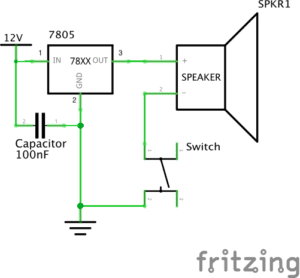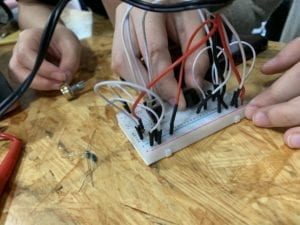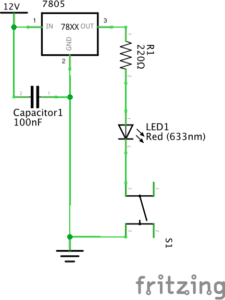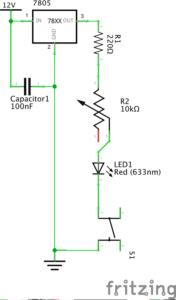Materials Used:
1 * Breadboard
1 * LM7805 Voltage Regulator
1 * Buzzer
1 * Push-Button Switch
1 * Arcade Button
1 * 220 ohm Resistor
1 * 10K ohm Resistor
1 * 10K ohm Variable Resistor (Potentiometer)
1 * LED
1 * 100 nF (0.1uF) Capacitor
1 * 12 volt power supply
1 * Barrel Jack
1 * Multimeter
Several Jumper Cables (Hook-up Wires)
Circuit 1

At first nothing was working for my partner me. I think this had to do with the fact that our breadboard was really unorganized and it was hard for us to really see clearly what was connected to what. After reorganizing and following the instructions carefully, we were able to get the speaker to work. The switch allowed us to connect or disconnect power to the LED, the capacitor stabilized the flow of electricity, and the voltage regulator stayed true to its name.

Circuit 2

This went much better for Lily and me. I think that our understanding of circuits strengthened and we enjoyed adding the button.
Circuit 3

This one was also very fun and we enjoyed adding the potentiometer that allowed us to control the brightness of the LED.
Question 1: After reading “The Art of Interactive Design,” in what way do you think that the circuits you built today include interactivity? Please explain your answer.
After reading Crawford’s analysis of what “interaction” really means, and what it does not, I am cautious in answering this question. He is clearly critical of how casually the term is thrown around and how the true meaning has been lost in the hype, but I appreciate the framework he provides in exchange. Crawford sees interaction as a conversation and an exchange that can be measured relatively rather than simply a boolean property. I think the circuits we made during recitation are representative of both. We were able to turn the speaker and light on and off and scale the brightness of the light. I feel like Crawford would classify this as, “silly and beneath the intellectual dignity of almost everybody” but at least it’s on the spectrum of interaction. There was input and output and somewhat of a conversation even though the components were not actors in Crawford’s most ideal sense.
Question 2: How can Interaction Design and Physical Computing be used to create Interactive Art? You can reference Zack Lieberman’s video or any other artist that you know.
I think that Zack Lieberman and his team’s work is a great example of interactive art. It not only uses interactive technology like eye tracking, but also allowed Tony Quan, otherwise known as “Tempt,” to interact with other artists. Unable to pursue his passion in the traditional sense, Quan, thanks to Lieberman’s eye tracking technology, is now able to continue tagging the streets of LA.
This is good documentation Amy. Just missing the final reflections but overall this is how the last ones should look like.